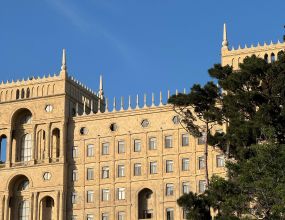
The Roma community in Azerbaijan has faced significant challenges throughout history, particularly during the Soviet era. From forced resettlements to harsh repressions, their story reflects a struggle for survival and cultural preservation under a regime intolerant of diversity.
Roma people began to settle in the countries of the Soviet Union, including Azerbaijan, starting from the 17th century. Considering the Soviet ideology's approach to various ethnic groups, it is not difficult to estimate their policy towards ethnic minorities. The intolerance and repressions of the 70-year totalitarian Soviet regime against diversity did icluded also Roma people. And all decisions were applied in all Soviet countries - as well as in Azerbaijan.
Initially, Roma people were classified as a class oppressed by the Roman Tsarist regime. It seems that the Bolsheviks were influenced by Roma collectivism. However, they did not realize that they could not control the Roma through strict politics. Recognizing that the new ideology was stranger to the Roma, the Bolsheviks immediately declared them as non-social and "unreliable elements," started a comprehensive fight against them.
The Roma, recognized as a nomadic people of Indian origin, were considered a national minority, and in 1926, the The Council of People's Commissars made a special decision regarding the lifestyle of the Roma, but naturally, compliance with this decision was not possible. A person without this important document had no chance to get anything from the government, including food cards. The 1930s were marked by severe famine in the USSR. All cities were divided into "closed" and "open" zones. As a rule, it was forbidden for Roma to settle in "closed" places, in big cities. The situation for the Roma who did not comply with the restrictions was pitiful, similar to other ethnic minorities. Mass deportations and imprisonment in camps began. Roma (many of them were wealthy) were sent to labor camps, and their property was confiscated. Later, anti-religious measures were initiated, and brochures about the dangers of religion were published. However, the Roma did not leave their customs, lifestyle, or religion.
In the 1930s, in the Azerbaijan SSR, many Roma were repressed and exiled to Siberia, as well as to selected regions of Azerbaijan. According to the decision of the Council of People's Commissars of the USSR dated December 17, 1936, No. 2123-420ss, "individuals who had been repressed for counter-revolutionary crimes, deserters, and criminals, along with their family members" were deported from the Azerbaijani SSR to the Kazakhstan SSR. It is not clear how many of the deportees were Roma, as the documents mention Armenians, Turks (568 families) and Kurds (553 families). However, it is noted that among the deported Turks, there were Roma as well.
Originally a Roma and an Islamic religious leader and teacher, Hasan Kamal oglu Niyazov, born in 1881, published a primer titled "Məktubi" in the Domari language using the Latin script in 1939 for the education of Roma children. The primer was used until the author was arrested in 1942 and deported to Iran.
Roma individuals migrating to cities hoped for better living conditions and employment opportunities. While some engaged in traditional activities such as begging and fortune-telling, others accepted the new government's rules and went to work in factories. They became acquainted with "honest labor" on a mass scale, and even Roma collective farms (kolxoz) were established.
As part of Stalin's repressions, the Roma living in the South Caucasus were deported to Kazakhstan from 1936, but the deportation decision was revoked in 1956. In 1956, the Soviet Union's Prime Minister Nikita Khrushchev issued an order regarding the settlement of the Roma. Consequently, in the 1950s and 1960s, Kurdish-speaking Roma began to come to Azerbaijan from Kazakhstan, identifying themselves as Kurds. The Roma predominantly live in the Yevlakh region, as well as in Barda, Goychay, Agsu, Agdash, Shamakhi, Zaqatala, and Xachmaz regions.
As part of this process, the Soviet government built houses and provided them to the Roma. Until the 1970s, Roma individuals were not conscripted into military service; it was only starting from the 1970s that Roma began to be called up for military service in the Soviet Armed Forces. In an effort to erase Roma identity, the Soviet authorities took measures such as writing "Azerbaijani" in the nationality section of their passports. Particularly in the 1970s, the Roma transitioned from their traditional nomadic lifestyle to a settled way of life. During the Soviet period, Roma individuals were provided with permanent employment as village residents in collective farms, while urban residents mostly worked in lower-skilled professions. In the late 1980s, many Roma women entered the clothing and cosmetics trade, which was quite limited at that time. In the 1970 census, 843 Roma were registered. In the 1960s, 100-120 Roma families moved to Azerbaijan, but in the 1989 census, 145 Roma were registered in Azerbaijan.
As far as we have seen, the Roma have also been among the people oppressed under Soviet ideology. However, the adaptation process of the Roma would be disrupted by the First Karabakh War, which began between Azerbaijan and Armenia at the end of the 80s.